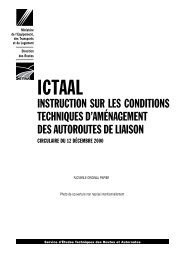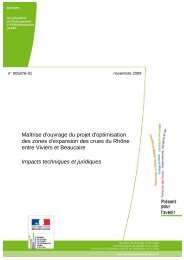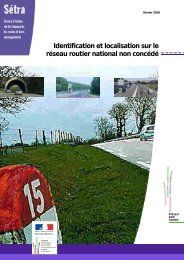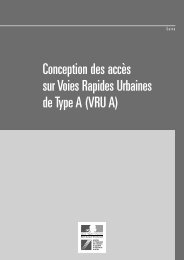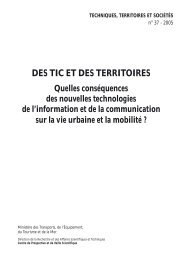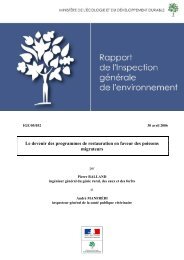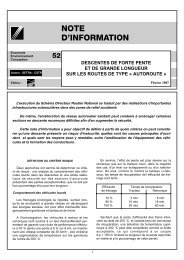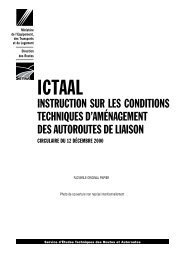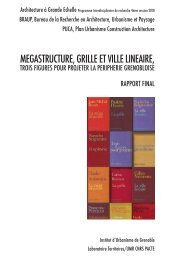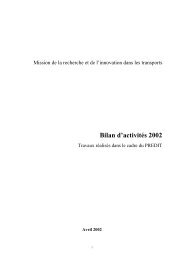Daniel Kaplan - Portail documentaire du Ministère de l'Ecologie
Daniel Kaplan - Portail documentaire du Ministère de l'Ecologie
Daniel Kaplan - Portail documentaire du Ministère de l'Ecologie
Create successful ePaper yourself
Turn your PDF publications into a flip-book with our unique Google optimized e-Paper software.
Each type of area must be able to function according<br />
to its own potential, integrating (mixing) different<br />
functions as much as possible. The future urban<br />
agglomeration can be conceived of as a network of<br />
complementary, synergetic locations, a network that<br />
is not hierarchically or<strong>de</strong>red. Complementarity<br />
constitutes a certain coherence which makes that the<br />
whole is more than the sum of its parts. But<br />
coherence or cohesion also requires both old and<br />
new means of communication: private cars, however,<br />
re<strong>du</strong>cing, automobile <strong>de</strong>pen<strong>de</strong>nce; (indivi<strong>du</strong>al)<br />
collective transport; seamless multimodal mobility;<br />
and, of course ICT connectivity. This is in<strong>de</strong>ed a<br />
challenging <strong>de</strong>sign task; how to organize complexity.<br />
Postmo<strong>de</strong>rn architects, consi<strong>de</strong>ring urbanism as “a<br />
bastion to the <strong>de</strong>nial of reality”, will disagree with<br />
this approach to urban agglomerations. They find<br />
concepts such as i<strong>de</strong>ntity, complementarity or<br />
coherence suspect as the entire notion of urbanism:<br />
“Urbanism or the building of settlements has<br />
not only become impossible, but no longer nee<strong>de</strong>d<br />
or, even worse, un<strong>de</strong>sirable, complicating things.<br />
Urbanism ceases to exist” (Kolhaas, 1998).<br />
An illustrative example of a networked city is<br />
the concept of an “integrated metropolis” <strong>de</strong>veloped<br />
by Roberts et al (1999).<br />
According to Roberts et al, the shape of cities is<br />
moving towards a polycentric or multi-centered<br />
form which functions as a whole. Attention is<br />
focused on transport interchange (nodal connections<br />
between the networks), the high street and the<br />
sub-center.<br />
Urban <strong>de</strong>signers, traditionally, have focused on<br />
the square and on site-based problems. The<br />
integrated metropolis offers the opportunity of<br />
extending the traditional concept of the public<br />
realm. It is rather turning into a place of connections<br />
between mo<strong>de</strong>s of transport, between public<br />
and private. Rather than replacing the physical by<br />
the virtual or digital, the exten<strong>de</strong>d concept of public<br />
realm comprises both traditional physical interactions<br />
(exchanges of goods, face-to-face social<br />
interactions) and virtual interactions (the exchange<br />
of information) (MacCormac, 1996).<br />
In <strong>de</strong>signing the integrated metropolis, one<br />
does not have to start from scratch, however. There<br />
are quite a few “classics” that offer sources of<br />
inspiration (Drewe 2000b).<br />
What needs to be done is to <strong>de</strong>velop rules or<br />
co<strong>de</strong>s for electronic or digital connectivity: “In or<strong>de</strong>r<br />
to <strong>de</strong>fine a coherent, working urban fabric, the<br />
pattern language of electronic connection (which is<br />
only now being <strong>de</strong>veloped) must tie in seamlessly to<br />
the language for physical connections. Already some<br />
ITC and Urban Design, a Paradigm challenge<br />
authors misleadingly <strong>de</strong>clare that the city is ma<strong>de</strong><br />
re<strong>du</strong>ndant by electronic connectivity. Such opinions<br />
ignore new observed patterns which correlate<br />
electronic no<strong>de</strong>s to physical no<strong>de</strong>s in the pe<strong>de</strong>strian<br />
urban fabric” (Salingaros, 2000, 8).<br />
To illustrate what the network at the “Network<br />
City” <strong>de</strong>sign studio is about (cf. figure n° 1), here are<br />
some topics that relate to the future urban agglomeration,<br />
that is the relation between ICT and urban<br />
form:<br />
– How to <strong>de</strong>sign a new resi<strong>de</strong>ntial area, taking into<br />
account ICT and hence in contrast to a VINEX<br />
location?<br />
– Can the New Urbanism approach from the United<br />
States inspire the <strong>de</strong>sign of a new resi<strong>de</strong>ntial area<br />
in the Netherlands, including a co<strong>de</strong> for ICT; once<br />
again, in contrast with a VINEX location?<br />
– And, vice versa, can the Dutch approach to<br />
urbanism make a contribution to planning a<br />
location in the United States including ICT and<br />
elements of new urbanism?<br />
– How to plan emergent Edge Cities in the<br />
Netherlands, compared to the US experience and<br />
what role can the urbanist play in this?<br />
– How can the national planning concept of<br />
“network cities” be applied to a corridor of two<br />
cities outsi<strong>de</strong> the Randstad and what would the<br />
planning and <strong>de</strong>cision-making process be like?<br />
– How to plan and <strong>de</strong>sign “the future urban agglomeration”<br />
in the periphery of the Netherlands as an<br />
ICT-based network urban no<strong>de</strong>s?<br />
– How can the urbanism of networks be changed<br />
into sustainable network urbanism: in <strong>de</strong>signing<br />
interfaces between ecological and urban infrastructures?<br />
– How to <strong>de</strong>sign a mixed resi<strong>de</strong>ntial-work<br />
environment interfacing with new wet grassland,<br />
using “light urbanism” and ICT?<br />
– How to combine ICT (a neighborhood telecenter)<br />
with sustainable construction to revitalize a<br />
waterfront area?<br />
– Design aspects of ICT applications in an existing<br />
neighborhood: catering to the needs of the el<strong>de</strong>rly<br />
(Caso, 1999).<br />
– Can ICT be used to help with the revitalization of<br />
a <strong>de</strong>prived neighborhood in a Dutch city<br />
empowering its resi<strong>de</strong>nts?<br />
– The same question only this time applied to cities<br />
in Latin America.<br />
– Design of personal travel services as part of a<br />
larger project on sustainable multimodal mobility<br />
including, among others, a <strong>de</strong>sign theory for<br />
intermodal transfer points in multimodal<br />
passenger transport networks.<br />
237



